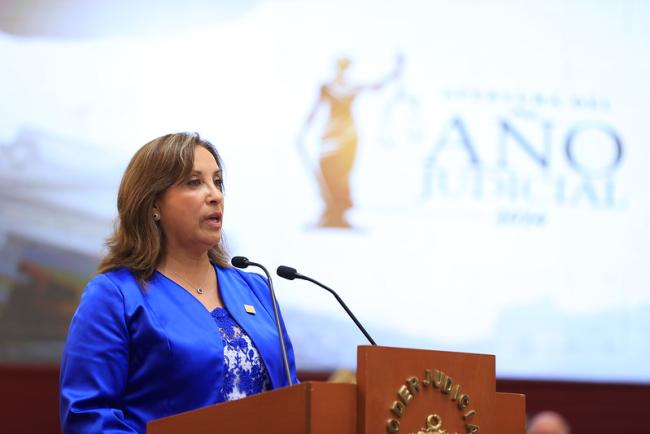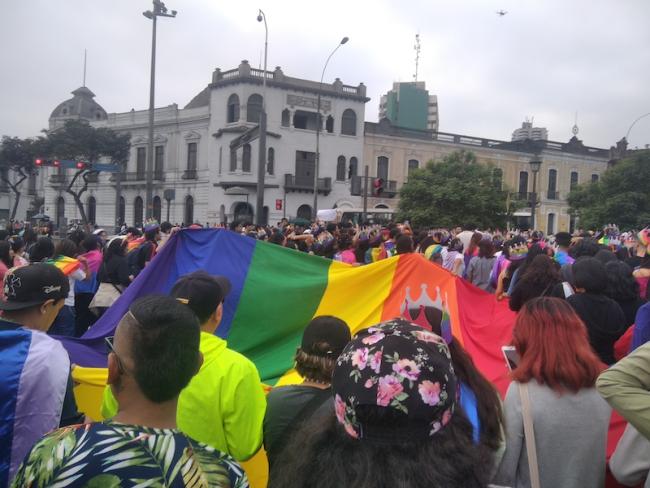
“It isn’t just the worker who suffers from the inequity of our laws, the vexations of power, and the tyranny of capital; all of us, to some extent, are mocked and exploited, we are all caught up in the immense tentacles of the state.” – Manuel González Prada
On Tuesday, June 25, two human rights organizations, the International Federation for Human Rights (FIDH) and Peru’s Association for Human Rights (APRODEH), issued a submission to the International Criminal Court against Peruvian President Dina Boluarte. In it, they accuse Boluarte of overseeing crimes against humanity, including the deaths and injuries of dozens of protesters between December 7, 2022 and February 9, 2023.
That this is the furthest any legal proceedings have gone in nearly two years despite the well-documented state violence against protesters speaks volumes to a generalized conspiracy in Peruvian politics. That the case of a few undeclared Rolexes owned by Boluarte caused a bigger outcry in the mainstream media says a lot about how little Indigenous, Afro-Peruvian, and campesino lives are valued. Not to mention, the recent declaration by former dictator Alberto Fujimori that he plans to run for president in 2026, following his highly controversial pardon after serving 16 years of a 25-year sentence for human rights violations and embezzlement, speaks to the decadence of the country and the influence the ideological doctrine of “Fujimorismo” still holds.
To properly understand Peru's perpetual governing crisis, we need to go beyond the conventional analytics of power that has taken the state as a given and understand the country's political violence on its own terms. Conventional frameworks of political stability are most often concerned with elections, the functionality of legislative organs, and GDP performance. However, these metrics do not tell the entire story and lose sight of the ways in which political hegemony continues to subjugate the country’s historically vulnerable populations.
After the ouster of President Martin Vizcarra, which triggered protests at the end of 2020 that were fueled by long-held resentment against an authoritarian Congress, we find a state where exceptional forms of violence are anything but exceptional.
Following Vizcarra’s ouster, a quick succession of presidents preceded the highly contested presidential election of 2021, when the unlikely campesino teacher Pedro Castillo defeated Keiko Fujimori, the daughter of the then-imprisoned former dictator. Former president Castillo’s swift arrest followed his ill-fated self-coup in December of 2022, when, like Vizcarra before him, Castillo tried to implement term limits and other reforms in the structure of Congress and also initiate the process for a constitutional assembly by dissolving Congress.
Since then, the ruling class has ostensibly backed his former Vice President Boluarte to serve as their political avatar while further entrenching a reactionary neoliberal agenda following the violent repression of protests in the south of the country in December 2022. After foregoing an earlier promise to move up the 2026 general elections by two years, the current Peruvian government has pushed through a number of sweeping bills to consolidate power in its legislative branch alongside reactionary violence against the most vulnerable populations.
Politics Have Always Been Personal
A tit-for-tat between different factions in the legislative and judicial chambers culminated in June when Congress removed two members of the independent National Board of Justice that oversees the appointment of judges and top prosecutors in the nation. This scandal first burst onto the public scene in November 2023, when then Attorney General Patricia Benavides presented a constitutional complaint against Boluarte for human rights violations during protests in January 2023. In response, Benavides was removed from her post just over a week later and placed under preventative detention. The attorney general was accused of being a member of a crime syndicate that courted favors from Congress in exchange for kickbacks and dismissing pending cases. Many analysts, while acknowledging the likelihood of the crime syndicate’s influence on the appointment of members of high-ranking judicial and prosecutorial offices, viewed the timing of Benavides’ removal as clear retaliation and politically motivated given that it came after Benavides opened a case against the president.
The removal of the two judges was just the beginning. On June 5, Congress moved forward with a constitutional amendment to eliminate the National Board of Justice altogether. This follows a slew of legislation that was passed or advanced in June’s congressional session, including shortening the statute of limitations for crimes against humanity and placing more hurdles on filing new complaints against members of Congress. The latter, which includes new amendments that would dissolve certain oversight bodies, is currently being discussed in the latest congressional period that started on July 27.
Commenting on the current wave of attacks on independent jurisprudence, Juanita Goebertus, the Americas director at Human Rights Watch, said, “Peruvian legislators are ramping up their actions to control judicial and electoral authorities, weaken accountability systems, and undermine oversight and criticism of their actions with a flurry of destructive legislation suddenly moving forward.” It is no wonder that both the president and Congress’ approval ratings have long been in the single digits.
Cultural Violence and the Underpinnings of Fascism
Peru’s reactionary politics extends into the social and cultural dimension as well, a classic characteristic of fascism. In a widely condemned bulletin released by the Peruvian government on May 10, the government reclassified the LGBTQ community as “mentally ill.” According to officials, the classification was necessary to give the LGBTQ community access to mental health resources.
Peru’s longstanding socially conservative and reactionary, if not anti-LGBTQ, social policies say otherwise. This is a country where gay marriage is still illegal and where LGBTQ communities face harsh discrimination from figures across both right- and left-wing parties, which share socially conservative values. In 2023, Peru’s ombudsman, Josué Gutiérrez Cóndor, a member of former president Castillo’s party, referred to queer people as needing to be “corrected.” Gutiérrez Cóndor, who has no background in human rights, was appointed by Congress to the ombudsman’s office to serve as the “people’s advocate” in one of Peru’s most challenging moments with regard to human rights. Gutiérrez Cóndor has counted on the support of Fujimorismo, reflecting an alliance between the nominal left and the far right that is more common than not in Peruvian politics.

In April, a group commissioned by the former education minister Miriam Ponce that was tasked with reviewing school textbooks and curriculum for themes and words deemed dangerous by the government completed its findings. As part of its investigation, the group examined 658 texts and found that 57 of them included words deemed “sensitive.” Of those 57 texts, the group recommended that 22 be removed from the curriculum for including terms such as “abortion,” “armed conflict,” and “gender focus,” among others. Although the new minister of education, Morgan Quero, has downplayed the threat of government censorship, many advocacy groups are on heightened alert as the government moves to obscure public criticism alongside judicial and independent oversight.
This is but one and arguably a lighter controversy compared to Quero’s most recent scandal: speaking on the topic of hundreds of teachers accused of carrying out sexual violence against Indigenous Awajún children in the Amazon province of Condorcanqui, Quero described the cases of child rape as “cultural practices” in Indigenous communities that may impede investigations. The deplorable and widely condemned comments reflected the prevalence of anti-Indigenous sentiments held by the ruling class. In response, a group of Awajún women leaders cited the government’s dismissive response, stating, “The words of these ministers convey a racist vision of Indigenous peoples that shows us as savages, justifying the attacks we receive.”
The indifference and neglect of the state go beyond rhetoric. According to Indigenous Amazonian communities, this neglect has led to the murders of numerous leaders in the region. In response to the recent killing of Kakataibo leader Mariano Isacama, which brings the number of Indigenous leaders killed in the last decade to 35, AIDESEP, the organization that represents Indigenous communities in the Amazon, has declared a permanent state of emergency. The use of the state of emergency is a tactic by communities to anticipate the power of the state, which itself has politicized and instrumentalized states of emergency to subdue mobilizations, such as in the southern region of Puno, which joined thousands who mobilized against the state during the national independence day on July 28.
In his book Late Fascism, the cultural critic Alberto Toscano argues that our conceptualization of fascism as a set of processes and ideals tends to be contingent upon how closely it compares to historical fascism. Instead, Toscano argues that fascism should not be understood as a set of principles analogous to Italian fascism; rather, it should be measured on its own terms as a mutable process. He goes on: “Fascism… strives violently to enshrine inequality under conditions of crisis by creating simulacra of equality for some—it is a politics and a culture of national-social entrenchment, nourished by racism, in a situation of real or anticipated social catastrophe.”
Fascism is not a common analytical framework for studying violence in Latin America, not least because it is often perceived to be a European condition. Yet, we find fascist practices both historically and in contemporary models of statecraft throughout the region. Putting aside the explicitly fascist and instead unmooring the term to see it for what it is—a logic of exclusion predicated on futurist ideals reinforced by the strict policing of conceptual and ideological borders—we find how indifference to the violence that occurs under everyday politics normalizes exceptional violence.
Understanding fascism beyond just the exceptional helps us to better see how the state functions upon exclusionary politics all the time, where historical violence against the most vulnerable populations carries on, whether the “right” or “left” is in power. While anti-corruption rhetoric and discourse on civility can be heard across the political spectrum in Peru, the normalization of Peru’s exceptional violence against marginalized populations and the centralization of power within a ruling elite based in the capital, Lima, carries on. The ongoing consolidation of power within Peru’s Congress alongside the reactionary policies managing cultural practices has clear fascist elements, if not so outright.
George Ygarza is a translator, popular educator, and postdoctoral researcher at Binghamton University. He writes on Peru and more general topics including mining, popular resistance, and state violence.

